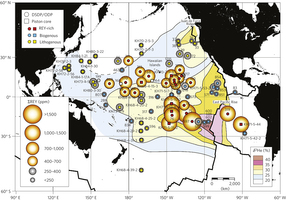Japanese team finds rare earth bounty

Japanese scientists have found a "huge" quantity of rare earth elements at the bottom of the Pacific Ocean that could meet at least one-fifth of the world's demand for materials crucial to the manufacture of high-end electronics.

Japanese scientists have found a "huge" quantity of rare earth elements at the bottom of the Pacific Ocean that could meet at least one-fifth of the world's demand. Image credit: Nature Geoscience
The find, described in Nature Geoscience on Sunday, means a single square kilometre of ocean floor near a mineral-rich site could meet 20 percent of global manufacturing demand for the elements, according to the University of Tokyo-led research team. At the moment, over 90 percent of rare earth elements are produced in China, which is home to around one-third of the world's land-based deposits.
"World demand for rare-earth elements and the metal yttrium — which are crucial for novel electronic equipment and green-energy technologies — is increasing rapidly," the scientists wrote in the paper. "Rare-earth elements and yttrium are readily recovered from the [Pacific Ocean floor] mud by simple acid leaching, and suggest that deep-sea mud constitutes a highly promising huge resource for these elements."
Rare-earth minerals are a family of 17 chemical elements — including yttrium — that are key to the production of modern electronics such as flash memory, cameras, military equipment, magnets and lasers. They are typically used in small quantities relative to the mainstay resources of copper, silicon and the like.
In March, China decided to raise taxes on mined rare earth minerals by between 10 and 120 times, driving up production costs. State media reported this would help drive small and medium-sized mines out of business and force consolidation in larger mining companies.
Scattered deposits
The Japanese researchers found deposits of the minerals scattered across the Pacific Ocean. Of the 78 sites they surveyed, one-third had large quantities of the elements. Previously, sediment deposits were not thought of as decent rare-earth and yttrium resources because of insufficient data, the researchers wrote.
Yasuhiro Kato, one of the scientists involved in the paper, told Reuters the deposits contain around 100bn tonnes of the rare earth elements. This compares with the 110m tonnes the US Geological Survey believes is found on land worldwide.
Elaborating, Kato said sea mud is especially rich in heavier rare earths such as gadolinium, lutetium, terbium and dysprosium. "These are used to manufacture flat-screen TVs, light-emitting diode valves and hybrid cars," he told Reuters.
In November, semiconductor industry market researcher The Information Network estimated that China's production of rare earth minerals will fall from its current 90 percent to 67.2 percent by 2014, as new mines in the US and other countries come online.
Get the latest technology news and analysis, blogs and reviews delivered directly to your inbox with ZDNet UK's newsletters.